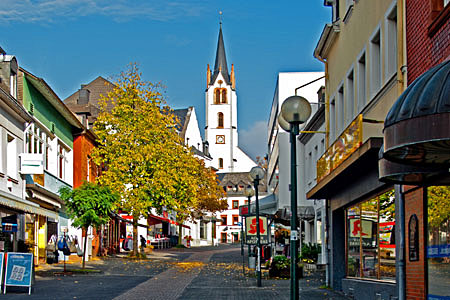
|

|

|

|
Hermeskeil with the GrimburgIn a valley basin in the westernmost part of Hunsrück lies the town of Hermeskeil, an ancient settlement at the crossing of two interregional trade routes, which already existed in the Bronze Age. Only a few kilometres away lies the most massive ringed wall area in Hunsrück, on Dollberg mountain near Otzenhausen, where there is an ancient settlement and a castle that was built during the Latène Age (500 to 20 B.C.) as the ancestral seat of an ancient Celtic dynasty. This was, at the time of the Roman conquest of the Gauls by Caesar(54 B.C.), supposedly the centre of power of the resident tribe of Treverians in this region. It is also not far to Trier from here, the 2000-year-old former Roman imperial residence "Augusta Treverorum". Due to its geographical proximity, Hermeskeil and the surrounding countryside belonged to the Trier Electorate and archiepiscopal seat during the Middle Ages. In the last century the town was also an important railway junction on the Hunsrück line. From here the route led out of the Nahe Valley from Langenlonsheim through Simmern to Hermeskeil and connected to Trier-Türkismühle (Nohfelden). Today only a museum for steam engines —complete with locomotives, a curved engine shed and turning platform— bears witness to this bygone era. A privately operated airplane exhibition on the road along the ridge of Hunsrück ("Hunsrückhöhenstraße") has almost 40 transportation and military machines on display. A visit to Hochwald Museum gives you a valuable insight into the local history of the Hunsrück region. A few kilometres southwest of Hermeskeil is Grimburg, high above Waldrill Valley. This former castle of the Trier Archbishop was built at the end of the 12th century as a border defence to guard the possessions of the Trier Church against the Earls of Sponheim and their expansionist ambitions. Under the similarly ambitious Trier Archbishop, Balduin von Luxemburg (1307-1354), Grimburg was the administrative seat of a head official and the post was granted as a fiefdom to the nobility in the region. Territorial disputes among the powerful were quite common at that time. An episode from the year 1328 between Archbishop Balduin and Loretta, Countess of Sponheim, who in the year 1324 became regent of the Back County of Sponheim provides evidence of this. The countess prevailed by taking the archbishop captive during a surprise coup. Balduin was only freed after five weeks confinement in the Sponheim fortress Starkenburg on the Mosel once an 11,000 farthing ransom had been paid and he signed a document agreeing to build Frauenburg castle near Birkenfeld. Grimburg castle, built on a mountain spur, must have been an important stronghold during the 13th and 14th centuries. Its proportions, on a 230 m by 100 m base surface, were considerable for those times. The settlement that arose at the foot of the castle, which had already received a town charter in the year 1332, was, nevertheless, abandoned again by the middle of the 16th century. A hundred years later, in the 17th century, after being pillaged by French troops, the Grimburg "office" was also closed and the castle was then left to deteriorate. Only the courtyard Grimburger Hof, deep in the Wadrill Valley, remained, and today there is an inn on this site. Due to the efforts of a local cultural heritage society, Grimburg has been rebuilt on its medieval foundations in the past decade. The old plans were used without, however, being able to be completely authentic. In any case, what has been created is a lovely setting for castle feasts and recitals. This is, of course, to say nothing of the, which the keep, towering on high, also offers the visitor a grand view over the Black Forest down into the Saarland region. |
|

Autumn in the town centre of Hermeskeil with its main street «Saarstraße» and the church «Sankt Martinus». |
|
|
| [ Mail to Webmaster ] info@maasberg.ch |